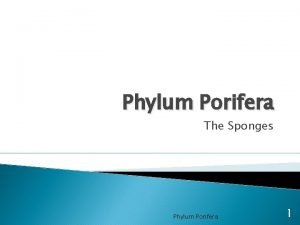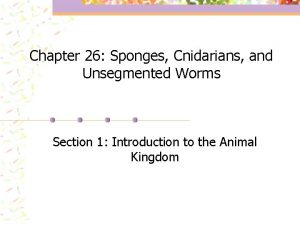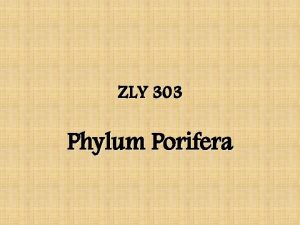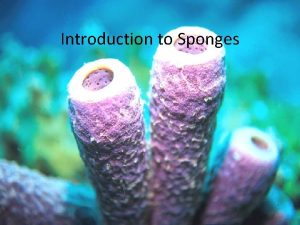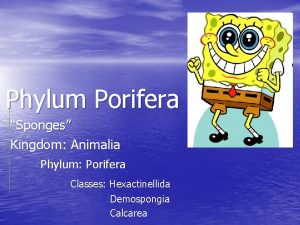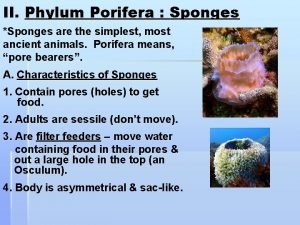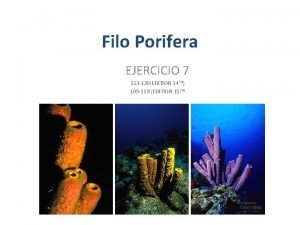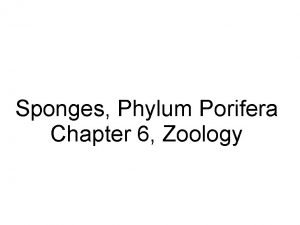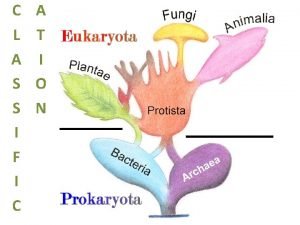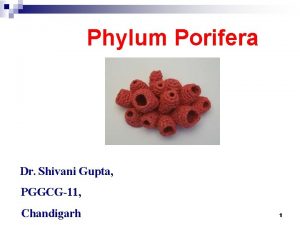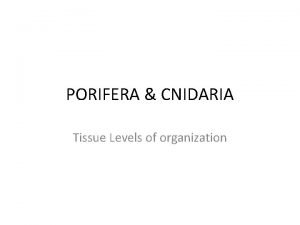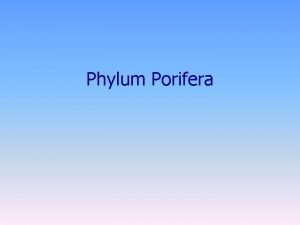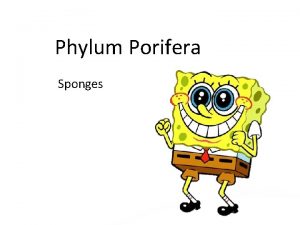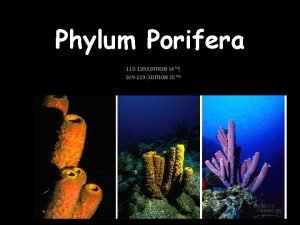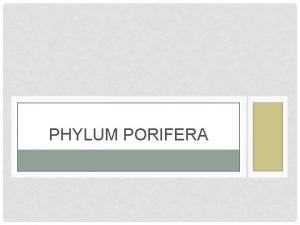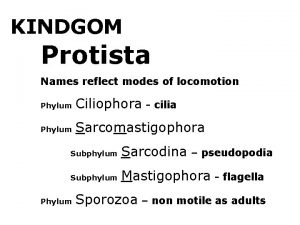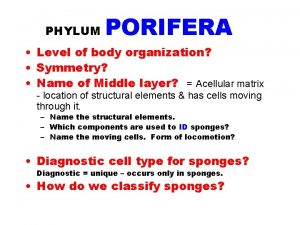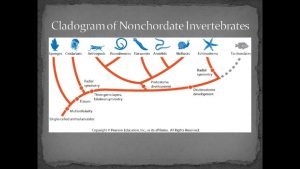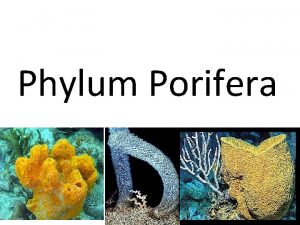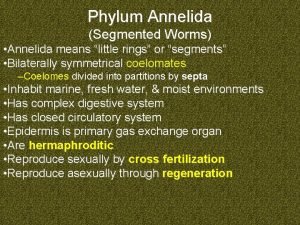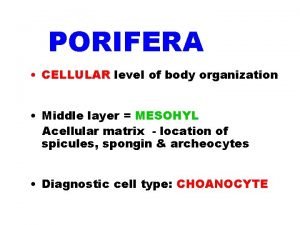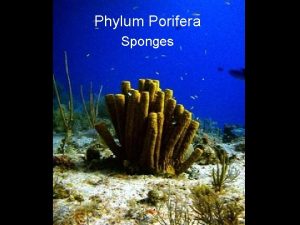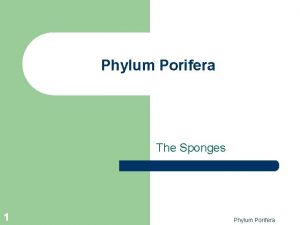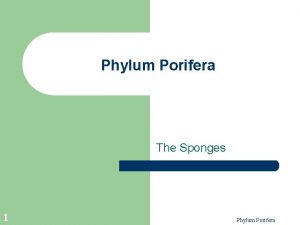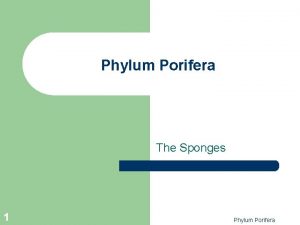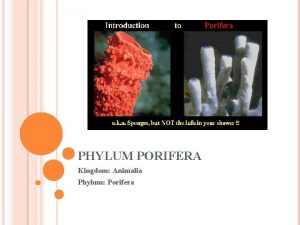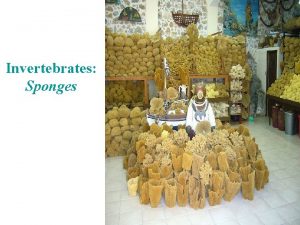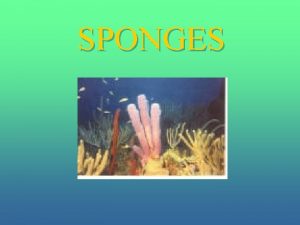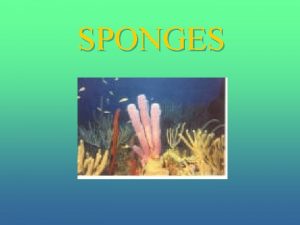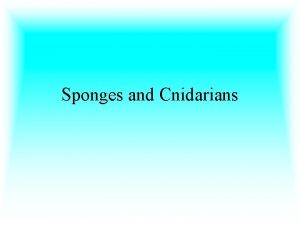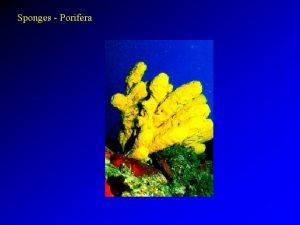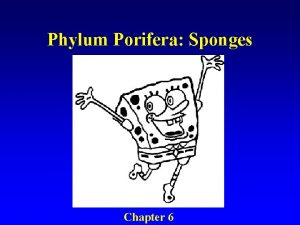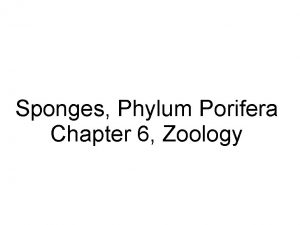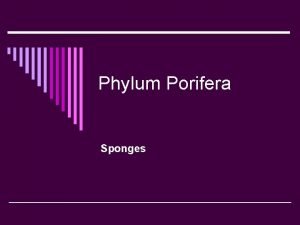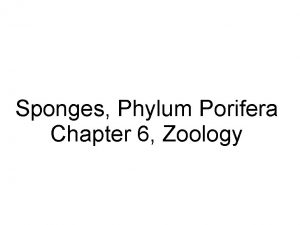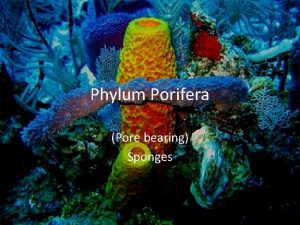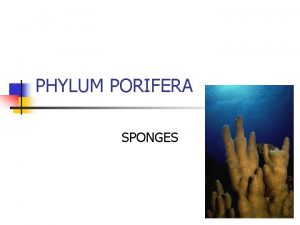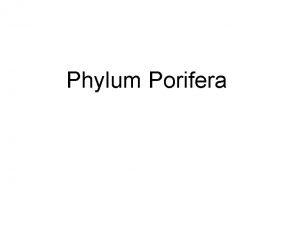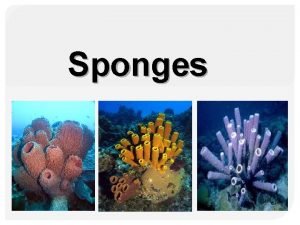Phylum Porifera 1 Phylum Porifera The Sponges Sponges








































- Slides: 40

Phylum Porifera 1

Phylum Porifera: The Sponges • Sponges are very simple animals that are part of Phylum Porifera • Porifera means “pore bearer” because the sponge has many small pores or openings in its body that allow water to flow through it • There around 9000 species of sponges, all of which are aquatic. Most are marine but about 100 species are freshwater. • Adults sponges are sessile. They grow attached to the substrate and do not move, so people used to think sponges were a type of plant. 2

• Sponges are some of the most primitive animals around. They are very simple, but they are still well adapted to their environments. • Sponges have been around for about 580 million years • Biologists used to think that the sponges were the first animals to diverge from the rest of the animal tree of life, making them a sister group to all other animals. 3

New data suggests that another group, the comb jellies (Phylum Ctenophora), actually diverged first, but sponges are still some of the simplest and most ancient animals in existence. 4

Sponge Body Plan • Sponges are asymmetrical, meaning their bodies do not display any type of symmetry. • Sponges are multicellular but they have no true tissues • Sponges have several types of specialized cells that perform different functions and life processes. 5

Sponge Body Plan • Sponges use a water current to perform almost all their essential life processes • Water enters the sponge through the many small incurrent pores called ostia (singular: ostium) • The water then enters the large central cavity of the sponge, the spongocoel • Finally, water exits through a large opening called the osculum. 6

• The water current is created by cells known as choanocytes which line the spongocoel (the central cavity). • The choanocytes beat their whip-like flagella to create the movement of water through the body of the sponge. • Choanocytes are also sometimes called collar cells because they have a sticky collar surrounding their flagella to catch food particles. In the diagram, you can also see the porocyte or pore cell through which the water enters the sponge. These cells are shaped like tubes and form the incurrent pores or ostia. 7

A choanocyte or collar cell performs two main functions. First, the flagellum creates the water current. Secondly, the sticky collar of microvilli filters food particles out of the water. The food particles, such as bacteria, stick to the sticky collar. 8

• Water flow is essential to basically all life processes for a sponge • The water current created by the choanocytes carries food and oxygen into the sponge • The water flow out of the sponge removes waste and is even used to disperse sperm when the sponge reproduces. 9

• Sponges have no true tissues but they do have several types of specialized cells • Choanocytes create the water current and filter food particles • Porocytes are hollow tube-like cells that allow water to enter the sponge • Pinacocytes make the outer layer of the sponge • Amoebocytes take food and nutrients to the cells of the sponge. They also have a special ability to turn into other specialized cell types such as oocytes (egg cells) and sclerocytes (the cells that make the sponge’s spicule skeleton) 10

These specialized cells are suspended and surrounded in a gel-like substance known as the mesohyl. The mesohyl fills the space in the sponge between the outer pinacoderm (the layer of pinacocytes that forms the outer covering) and the inner layer of choanocytes. It suspends the cells and acts a bit like an endoskeleton, giving the sponge support and structure. 11

1 2 Did you know? Sponges are filter feeders. To get enough particles out of the water to sustain themselves, they have to filter incredible quantities of water. By some estimates, a 1 kg sponge can filter up to 24, 000 liters of water per day!

Feeding & Internal Transport • Sponges are filter feeders, meaning they filter food particles directly from the water. • The sponge uses their choanocytes to create a water current into the sponge. The water carries with it small particles of food such as bacteria or small algae. • These particles stick to the sticky collar of microvilli on the choanocyte. • The choanocyte ingests the food particles by phagocytosis, completely engulfing them. It then passes the food onto the amoebocyte cells. • The amoebocytes then move through the gellike mesohyl (middle layer of the sponge) and distribute food throughout the body. 13

Internal Support (Skeleton) • Sponges don’t have bones, but they do have parts inside them that give them structure and support like a skeleton does. • The sponge skeleton is made up of hard particles called spicules and a spongy protein known as spongin • Spicules may be made of silica or calcium carbonate. • Spongin is made of hardened protein. • The type of skeleton, what it’s made of, and the shape of any spicules is one very important way to classify sponges. 14

Skeletons SPICULES VENUS FLOWER BASKET

Sponge Skeletons Silica Spicules Calcium Carbonate Spicules SPONGIN


Respiration • Sponges rely on diffusion and the water current flowing through the sponge for respiration • The water brings in O 2 (oxygen) and removes CO 2 (carbon dioxide) • The sponge does not use any specialized organs for respiration. Response • Sponges have NO nerve cells nor specialized sense organs • They DO respond to their environment, though. For example, when sponges get covered in sediment, they temporarily stop filtering to avoid damage. 18

Excretion • Sponges use diffusion and the water current to remove metabolic wastes • The wastes diffuse out of the cells and are removed from the sponge by the flowing water 19

2 0 Did you know? • Sponges can range in size from tiny (1 cm) to massive (2 meters or over 6 feet tall!)

Reproduction - Asexual • Reproduction in sponges can be both sexual and asexual • Asexual reproduction creates a clone of the sponge. Sponges can reproduce asexually through … • Budding: a part of the sponge grows off the parent, eventually becoming a new sponge • Fragmentation: part of the sponge breaks off, settles on the sea floor, and forms a new sponge • Gemmules: gemmules are sphere-shaped groups of amoebocytes surrounded by a tough layer of collagen (spongin) and spicules. They are hardy structures that can be used to survive unfavorable conditions or cold temperatures. They are found mostly in freshwater species. A gemmule

Reproduction - Sexual • Sponges also reproduce sexually • Sponges are monoecious or hermaphroditic, meaning each sponge forms both sperm and eggs • Eggs are formed by amoebocytes differentiating into oocytes, while sperm are derived from choanocytes • Eggs are kept inside the sponge • Sperm are released into the water and, if they encounter another sponge of the same species, may enter the sponge and fertilize an egg • The egg develops into a larva inside the sponge. The larva is eventually released. The larva is free-swimming and is the only motile part of the sponge life cycle. • The larva eventually settles onto the substrate or sea floor and develops into a new sessile adult sponge

Ecology • Sponges are very important to the ecology of their environments: • Sponges form numerous symbiotic relationships with bacteria and algae • They provide a habitat for other marine animals, such as worms, shrimp, snails, and sea stars • Sponges are filters, improving water quality and removing bacteria 23

Economic Impact: Bath Sponges • Most sponges we use today are synthetic • However, some bath sponges are still natural sponges that have been harvested from the wild • Not all sponges make good bath sponges. Only certain types containing spongin rather than hard spicules are soft enough to be useful. • Bath sponges are harvested mostly from a few Mediterranean and Caribbean countries 24

Human Impact: New Medicines and Cancer Drugs • Since adult sponges are sessile and cannot move, they protect themselves by making toxic compounds • Some of these compounds fight against viruses, bacteria and fungi • Humans can synthesize these chemicals, using them to make new types of drugs to fight illnesses and even cancer 25

British Columbia’s Glass Sponge Reefs • Some incredibly rare sponges known as glass sponges are found right off the coast of British Columbia! • Glass sponge reefs were believed to have gone extinct 40 million years ago until they were rediscovered off BC’s coast in 1987 • These reefs are 9000 years old and are found nowhere else in the world than in a few special spots off our coastline such as in the Hecate Strait • The reefs span over 1000 square kilometres and can reach the height of an 8 storey building! 26

• BC’s glass sponge reefs are very ecologically important. Not only are the found nowhere else in the world, they provide important habitat to marine creatures and improve the water quality • However, the glass sponges are fragile and can be easily destroyed by human activities. Fishing activities such as trawling can destroy the fragile reefs • The sponges can also be damaged by pollution and sediment which can clog their pores, stop the flow of water, and smother them. • A new reef was discovered in 2014 under a commercial salmon farm in Chatham Sound. The waste from the farmed salmon had smothered and killed the reef. 27

Some glass sponge reefs in BC are now protected areas where fishing and human activities are not allowed. However, other reefs are still vulnerable. You can advocate for the protection of these reefs. Check out CPAWS for info. 28

Before you go … • Check out the video links on the next slide to learn more about sponges. • Look at the images of different types of sponges to appreciate their incredible diversity and morphology • Read about a sponge/shrimp love story and how male and female Venus flower basket shrimp end up paired for life inside a glass sponge cage: https: //schmidtocean. org/cruiselog-post/a-deep-sea-love-story/ 29

Please watch these recommended videos: Sponges! Jonathan Bird’s Blue World: https: //www. youtube. com/watch? v=m 8 a 0 o. Ns. DEx 8 Shape of Life Sponges https: //www. youtube. com/watch? v=_0 ftk-1 re 8 Y Sponges: Oldest Creatures in the Sea https: //www. youtube. com/watch? v=yk. Kd 8 js. CREQ Spicules: How sponges ‘spike’ themselves with glass: https: //www. youtube. com/watch? v=JZUO 3 l 4 U-a. Y A look at rare, beautiful “glass” sea sponges off the coast of B. C. : https: //www. youtube. com/watch? v=0 PDAirv. VGHw Rare glass sponge reefs found off B. C. coast news clip: https: //www. youtube. com/watch? v=IYz 5 -Mo. GY 4 Proposed protection of glass sponge reefs not enough: CPAWS: https: //www. youtube. com/watch? v=X 6 Lu. F 0 va 0 f 4 What is a Glass Sponge https: //www. youtube. com/watch? v=c 4 c 9 d 3 o 5 Uko This Week in History: The Fascinating World of Sponges (Royal BC Museum): https: //www. youtube. com/watch? v=8 Ev. CTU 5 H 3 Bc&feature=youtu. be Bonus viewing if you’re really interested in sponges now: CPAWS Sea of Glass Event – lecture by Dr. Sally Leys on Glass Sponges and Glass Sponge Reefs: https: //www. youtube. com/watch? v=oe. A 4 WTh 4 fsw A day in the life of a glass sponge researcher: https: //www. youtube. com/watch? v=9 J 7 Ci 6 b. Hn. OQ The Best Documentary Ever – Biological Fiber Optic Nanotech Venus’ Flower Basket: https: //www. youtube. com/watch? v=GEmo. Qzsv. PQ 0 (starts to repeat right at the end) 30





Rope Sponges

Ball Sponges

Barrel Sponges

Vase Sponges

Stove Pipe Sponge

Branching Tube Sponge
 Ostia porifera
Ostia porifera Sponges belong to the phylum
Sponges belong to the phylum Esponja do mar
Esponja do mar Phylum porifera is classified based on
Phylum porifera is classified based on Phylum porifera
Phylum porifera Sponges unique characteristics
Sponges unique characteristics Porifera
Porifera Asconoid syconoid and leuconoid sponges
Asconoid syconoid and leuconoid sponges Amoebocyte function
Amoebocyte function Potassium-argon dating
Potassium-argon dating Phylum porifera
Phylum porifera Porifera importance
Porifera importance Cnidaria organization level
Cnidaria organization level Porifera character
Porifera character Sponge body plan
Sponge body plan Phylum porifera
Phylum porifera What does porifera mean?
What does porifera mean? Foramnifera
Foramnifera Porifera symmetry
Porifera symmetry Vissoral
Vissoral Phylum porifera characteristics
Phylum porifera characteristics Means little rings
Means little rings Level of organization porifera
Level of organization porifera Hát kết hợp bộ gõ cơ thể
Hát kết hợp bộ gõ cơ thể Các loại đột biến cấu trúc nhiễm sắc thể
Các loại đột biến cấu trúc nhiễm sắc thể Thế nào là sự mỏi cơ
Thế nào là sự mỏi cơ Vẽ hình chiếu đứng bằng cạnh của vật thể
Vẽ hình chiếu đứng bằng cạnh của vật thể độ dài liên kết
độ dài liên kết Hệ hô hấp
Hệ hô hấp Chó sói
Chó sói Môn thể thao bắt đầu bằng từ đua
Môn thể thao bắt đầu bằng từ đua Thiếu nhi thế giới liên hoan
Thiếu nhi thế giới liên hoan điện thế nghỉ
điện thế nghỉ Một số thể thơ truyền thống
Một số thể thơ truyền thống Trời xanh đây là của chúng ta thể thơ
Trời xanh đây là của chúng ta thể thơ Ng-html
Ng-html Số nguyên tố là số gì
Số nguyên tố là số gì Phối cảnh
Phối cảnh Các châu lục và đại dương trên thế giới
Các châu lục và đại dương trên thế giới Từ ngữ thể hiện lòng nhân hậu
Từ ngữ thể hiện lòng nhân hậu Chụp phim tư thế worms-breton
Chụp phim tư thế worms-breton
